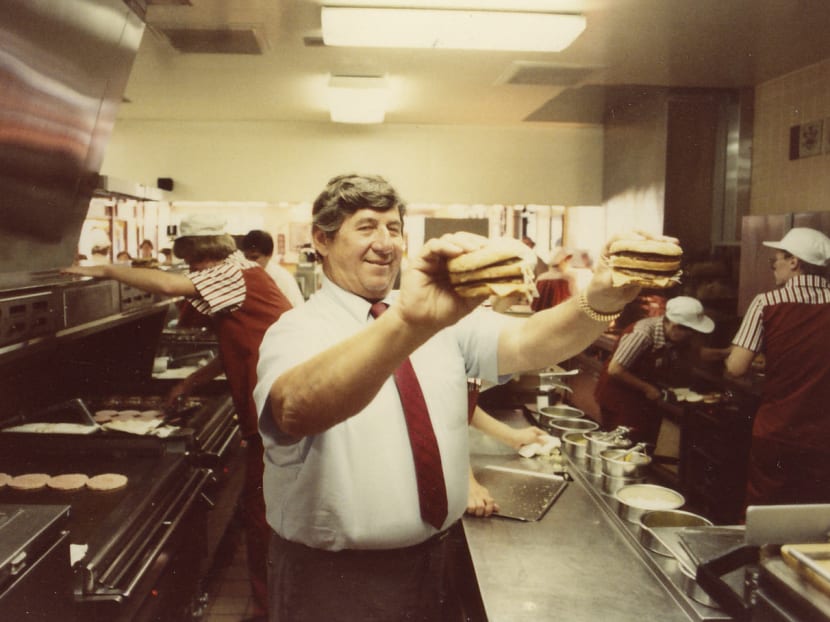Creator of McDonald’s Big Mac, Michael James Delligatti, dies at 98
PENNSYLVANIA — In April 1967, hamburger lovers in Uniontown, Pennsylvania, south of Pittsburgh, met a newer, bigger burger. Introduced by a local McDonald’s, it was called the Big Mac, and for US$0.45 (S$0.65) it delivered, as a 1970s jingle would have it, “two all-beef patties, special sauce, lettuce, cheese, pickles, onions on a sesame-seed bun”.

In an undated handout photo, Jim Delligatti. Delligatti, the McDonald’s franchise owner who invented the Big Mac, died on Monday at his home in Fox Chapel, Pa. He was 98. Photo: McDonald’s via The New York Times
PENNSYLVANIA — In April 1967, hamburger lovers in Uniontown, Pennsylvania, south of Pittsburgh, met a newer, bigger burger. Introduced by a local McDonald’s, it was called the Big Mac, and for US$0.45 (S$0.65) it delivered, as a 1970s jingle would have it, “two all-beef patties, special sauce, lettuce, cheese, pickles, onions on a sesame-seed bun”.
Response was positive. A year later, the Big Mac was on the menu at McDonald’s restaurants all over the United States. By 1969, it accounted for 19 per cent of the company’s total sales. Today, the company sells about 550 million Big Macs annually in the United States alone, and millions more in 100 countries around the world.
Jim Delligatti, the McDonald’s franchise owner who invented the Big Mac, died on Monday (Nov 28) at his home in Fox Chapel, Pennsylvania. He was 98. The death was confirmed by his son Michael.
Delligatti, who opened the first McDonald’s in western Pennsylvania in 1957, owned about a dozen franchises in the Pittsburgh area by the mid-1960s, but he struggled to compete with the Big Boy and Burger King chains.
He proposed to company executives that they add a double-patty hamburger to the McDonald’s menu, something along the lines of the Big Boy, that could put a dent in sales of Burger King’s Whopper.
He met with resistance. Top executives worried that any addition to the limited McDonald’s menu would gum up the works, and that a higher-priced burger — the basic McDonald’s hamburger cost just 18 cents — would alienate customers. After lobbying by Ralph Lanphar, a regional manager in Columbus, Ohio, headquarters gave Delligatti permission to test the Big Mac in Uniontown, using only McDonald’s ingredients.
Two patties, etc, did not fit on a standard McDonald’s bun, so Delligatti went rogue, ordering a large sesame-seeded bun from a local baker. He split it in three and assembled the Big Mac as the world knows it today, with a special sauce of his own devising.
It was introduced on April 22, 1967, with newspaper ads describing it as “made with two freshly ground patties, tangy melted cheese, crisp lettuce, pickle and our own Special Sauce”.
“It wasn’t like discovering the lightbulb,” Delligatti told John F Love, the author of McDonald’s: Behind the Arches (1986). “The bulb was already there. All I did was screw it in the socket.”
Michael James Delligatti was born on Aug 2, 1918, in Uniontown. His father, James, held a variety of jobs, from farrier to candy maker, and the family moved often. His mother, the former Lucille Dandrea, was a homemaker.
After graduating from Fairmont High School in West Virginia, Delligatti held a variety of jobs before entering the Army in 1942. He served in Europe with the 26th Infantry Division, known as the Yankee Division.
He worked a succession of odd jobs on returning home before hitchhiking to Southern California, where he worked at several drive-in restaurants and managed a Big Boy, whose feature hamburger with special sauce made an impression.
In 2012, a corporate chef for McDonald’s demonstrated, in a video, how to make the Big Mac Special Sauce, using mayonnaise, sweet pickle relish, yellow mustard, white wine vinegar, garlic powder, onion powder and paprika.
In 1953, Delligatti and a friend, John Sweeney, combined their last names and opened a drive-in restaurant in Pittsburgh, Delney’s.
While attending a restaurant trade show in Chicago in 1955, Delligatti became interested in the McDonald’s booth. He then visited a new McDonald’s in Illinois.
He became one of the company’s earliest franchisees, opening a McDonald’s in Pittsburgh in 1957. He went on to open 47 more over the next 25 years.
Along the way, he began serving a hot breakfast to local steelworkers coming off the night shift. As with the Big Mac, the Hotcakes and Sausage Meal became part of the national McDonald’s menu.
The Big Mac remains his legacy, celebrated in song and story. In 1986, The Economist introduced its Big Mac Index, which shows whether a currency is overvalued or undervalued based on the cost of a Big Mac in one country relative to the cost in another.
With backing from McDonald’s, Delligatti opened the Big Mac Museum Restaurant in North Huntingdon, Pennsylvania, in 2007, with a 14-foot-tall (4m) Big Mac sculpture as its centrepiece.
In addition to his son Michael, Delligatti is survived by his wife, the former Eleanor Carmody, known as Ellie; another son, James; five grandchildren; and eight great-grandchildren.
Last week, McDonald’s began testing two new versions of the Big Mac in Texas and central Ohio: A Mac Jr and a supersize Grand Mac Big Mac, in other words, might become Middle Mac. But the sales remain huge, leading many to believe that Delligatti, as its inventor, must have reaped a windfall worth billions.
Not so.
“All I got was a plaque,” he told the Pittsburgh Post-Gazette in 2007. THE NEW YORK TIMES





